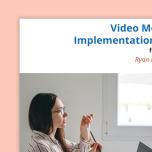Video Modeling

A teaching strategy that uses a video recording to model a targeted behavior or skill.
When to use:
- To teach a wide variety of behaviors and skills.
How to use:
- Identify and create a goal for the target behavior/skill to be taught.
- Create a task analysis of the skill.
- Collect baseline data to identify skills the student may already have.
- Begin teaching at the step the student cannot complete independently. This may or may not be the first step.
- Gather equipment: You will need a recording device (such as a video camera, IPad, etc.) and a playback device (computer, DVD, IPad, etc.)
- Plan for recording: Find a model for the video (when possible use peers), obtain consent/permission, a script can be helpful for the model, identify location(s) for recording, identify type of video modeling (learn more on this below in Variations.)
- Record video that accurately reflects the target behavior/skill. It may be necessary to edit the video to remove inaccuracy, errors, prompts, or to add voice-over(s) if necessary.
How to teach:
- Identify the environment for showing the video to the student.
- Teaching/practice should be in the most natural setting/routines.
- Determine when and how often the video will be shown.
- Ensure materials used in video matches materials used in practice.
Show the video:
- Staff may prompt during showing if needed to maintain student’s attention.
- Show the video a predetermined amount of times prior to expecting the student to practice the target behavior/skill.
- Reinforce practice of target behavior/skill.
- Monitor the data trends and make adjustments as necessary. This could be changes such as: revising task analysis, re-recording video, adding voice-over, prompting levels, etc.
- Have a plan for fading the video and prompting once the student’s data meets a predetermined criteria.
Tips:
If the student is not making progress:
- Does the student have the prerequisite skill of imitation?
- Are changes needed to the video modeling procedure?
- Is the video too complicated?
- Is the student attending to the relevant parts of the video?
- Is the student watching enough times per week?
- Is the prompting level appropriate?
- Is the reinforcer strong enough and given at the appropriate rate?
Variations:
- Video self-modeling:
- The student is the model in the video.
- Appropriate to use when the behavior/skill is already in the student’s repertoire but they may need to use it more often, or consistently.
- Point-of-view video modeling:
- This type shows how the behavior/skill will look from the student’s perspective (think of the view if a camera was fixed to a helmet.)
- Appropriate to use when a student needs support identifying relevant stimuli and/or has difficulty with Theory of Mind.
- Video prompting:
- Each step is recorded and video is paused/stopped at each step to allow the student to perform that step.
- Use the data collected to determine when to intentionally increase the number of steps before a pause/stop until the student can complete the entire sequence at once.
- Appropriate to use for a behavior/skill with many steps and/or for a student who progresses slowly.


